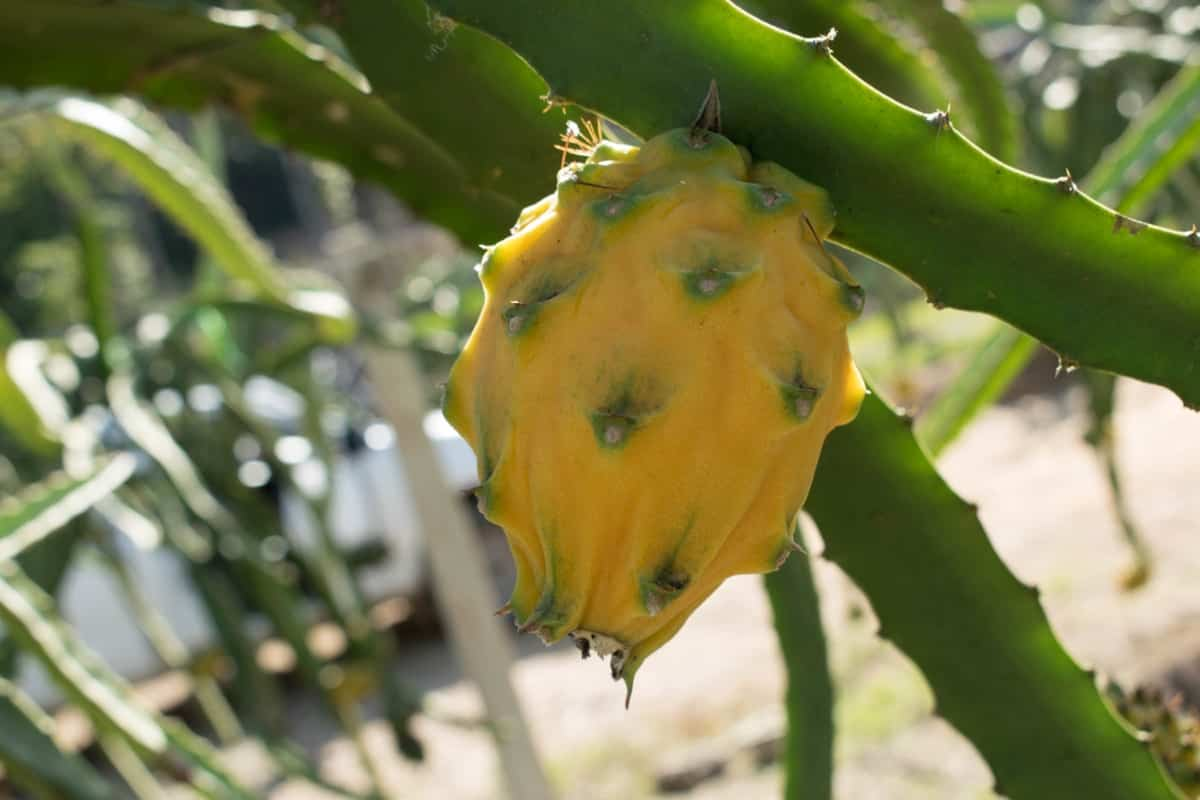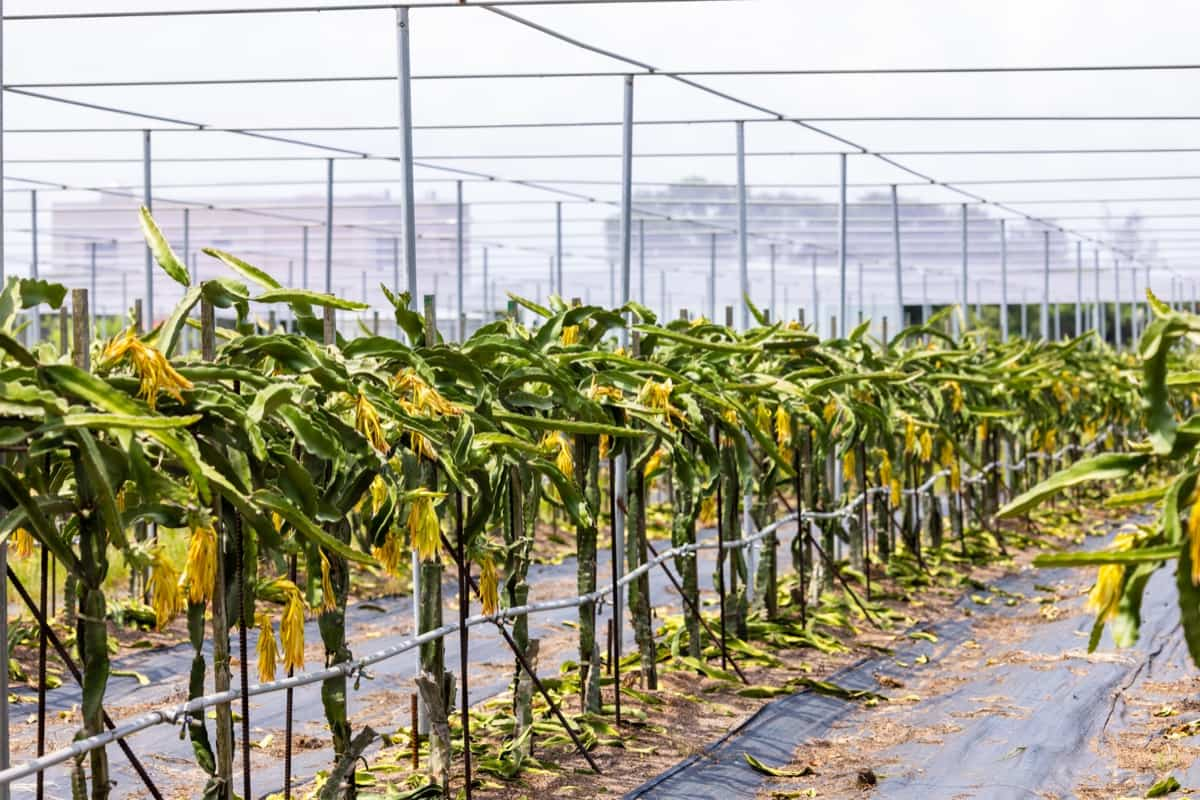Dragon fruit, also called pitaya, is a tropical fruit becoming increasingly popular for cultivation. To prepare the soil for dragon fruit cultivation, you’ll need to create the right conditions to ensure the plants thrive. Here’s a step-by-step guide on how to prepare the soil for dragon fruit cultivation.

How to Prepare the Soil for Dragon Fruit Cultivation
Soil Requirements for Dragon Fruit Cultivation: Dragon Fruit Soil Requirements
Dragon fruit (Pitaya) thrives in well-drained, slightly acidic to neutral soil with a pH between 5.5-7. A sandy loam or loamy soil promotes root aeration and water drainage. Good organic matter content and proper structure are crucial for moisture retention and nutrient availability. Ensure soil is rich in organic matter, such as compost, to enhance fertility.
Adequate drainage is essential to prevent waterlogging. Dragon fruit plants are sensitive to excess salts, so avoid saline soils. Regular soil testing and amendments can help maintain optimal healthy growth, flowering, and fruit production conditions.
Assessing and Improving Soil Drainage for Successful Dragon Fruit Growth
Firstly, evaluate the existing soil by conducting a percolation test to determine drainage capacity. If drainage is inadequate, consider amending the soil with organic matter, like vermicompost or well-aged manure, to enhance its structure and drainage capabilities. Raised beds or mounds can further improve drainage.
Installing a drainage system, such as perforated pipes, can aid in excess water removal. Proper plant spacing and avoiding overwatering are essential. Monitoring soil moisture levels and ensuring containers or beds have adequate drainage holes are key practices for promoting successful dragon fruit growth.
Steps to Prepare Nutrient-Rich Soil for Dragon Fruit Planting
Creating the Ideal Soil pH for Dragon Fruit Cultivation
- The ideal dragon fruit soil pH for cultivation ranges from 5.5 to 7. To create the ideal pH
- Test the soil’s existing pH level using a soil testing kit.
- If the pH is too low (acidic), raise it by incorporating lime, which gradually increases pH.
- If the pH is too high (alkaline), lower it by adding sulfur, ammonium sulfate, or acidic organic materials like peat moss.
- Mix the pH-adjusting amendments well with the soil and retest until the desired range (6.0 to 7.5) is achieved.
In case you missed it: Essential Tools and Equipment for Dragon Fruit Farming

Incorporating Organic Matter into the Soil for Dragon Fruit Farming
Begin by preparing the planting area, ensuring it’s well-drained. Spread a layer of well-rotted compost or aged manure, approximately 4-6 inches deep, over the soil surface. Gently work the organic matter into the 8-12 inches of topsoil using a garden fork or tiller. This process improves soil structure, enhancing water retention and nutrient availability.
Organic matter also fosters beneficial microbial activity. Allow the amended soil to settle for a few weeks before planting. Regularly replenish organic matter to sustain soil fertility, promoting vigorous growth and abundant fruiting in dragon fruit plants.
Managing Soil Moisture Levels for Optimal Dragon Fruit Growth
- Monitor Soil Moisture: Use a soil moisture meter or dig a small hole to assess moisture levels regularly.
- Watering Schedule: Provide consistent, deep watering. Water deeply but infrequently to promote deep-root development.
- Mulching: Apply an organic mulch around the plant to retain moisture, suppress weeds, and regulate soil temperature.
- Avoid Waterlogging: Ensure proper drainage to prevent water accumulation and root rot.
- Adjust for Weather Conditions: Increase watering during dry spells and reduce during rainy periods.
- Use Drip Irrigation: Drip systems deliver water directly to the roots, minimizing evaporation.
- Apply Organic Matter: Well-rotted compost aids in moisture retention.
Controlling Weeds and Pests in Dragon Fruit Soil Preparation
To manage weeds, begin by clearing the planting area of existing vegetation. Apply a weed barrier or organic mulch to suppress weed growth. Regular manual weeding can also be necessary. As for pests, inspect the soil and plant material for signs of infestations. Introduce beneficial insects and nematodes to control soil-dwelling pests naturally.
In case you missed it: Irrigation Techniques for Maximizing Dragon Fruit Yield

If necessary, employ organic pesticides. Proper sanitation and crop rotation can help prevent pest buildup. A healthy, weed-free environment during soil preparation sets the foundation for a successful and pest-resistant dragon fruit plantation.
Adjusting Soil Texture and Structure for Dragon Fruit Planting
- Test the soil for texture (sandy, loamy, or clay) and structure (compacted, well-drained, etc.).
- If soil is clayey or sandy, amend with organic matter like vermicompost to improve moisture retention (in sandy soil) or drainage (in clay soil).
- Add perlite or vermiculite for aeration and better root development in heavy clay soils.
- Ensure proper drainage by planting raised beds or mounds or adding coarse materials like gravel.
- Till and break the compacted soil with a garden fork to enhance root penetration.
Enhancing Soil Fertility for Healthy Dragon Fruit Plants
- Add Organic Matter: Incorporate well-rotted compost or aged manure to increase organic content, improve soil structure, and provide essential nutrients.
- Balanced Fertilization: Apply a balanced, slow-release fertilizer with micronutrients, maintaining a pH between 5.5-7 to optimize nutrient availability.
- Micronutrient Supplementation: Address specific deficiencies with targeted micronutrient supplements like iron, magnesium, or zinc.
- Crop Rotation: Rotate with nitrogen-fixing plants to naturally enrich the soil.
Preparing the Soil Bed and Planting Holes for Dragon Fruit Cultivation
- Choose a well-drained, sunny location.
- Create raised beds. If not, make mounds to improve drainage and aeration.
- Amend the soil with organic matter, like vermicompost or aged manure, to enhance fertility.
- Space rows of dragon fruit plants at least 10 feet apart.
- Dig planting holes 1.5 to 2 feet wide and deep, ensuring adequate space for root development.
- Incorporate organic matter into each hole and mix with the native soil.
- Plant dragon fruit cuttings or seedlings, positioning them vertically and ensuring the top node is above ground level.
Frequently Asked Questions
What Type of Soil Is Best for Dragon Fruit?
Dragon fruit thrives in well-draining, sandy, or loamy soil with a bit acidic to neutral pH range between 5.5 and 7.0.
Is Cocopeat Good for Dragon Fruit?
Yes, cocopeat is a good growing medium for dragon fruit. However, it’s important to mix cocopeat with other components like perlite or sand to ensure optimal conditions for dragon fruit growth.
In case you missed it: Effective Pest and Disease Management in Dragon Fruit Farms

Can Dragon Fruit Grow In Normal Soil?
Dragon fruit can grow in normal soil if the soil is well-draining and not overly compacted. However, it’s important to amend the soil with organic matter and ensure proper drainage to improve its growth and overall health.
Is Clay Soil Good for Dragon Fruit?
Clay soil tends to be heavy and poorly draining. It can lead to waterlogged roots, detrimental to the plant’s health. To grow dragon fruit successfully, it’s recommended to use a well-draining cactus or succulent mix or amend clay soil with organic matter and sand to improve drainage.
Is Sandy Soil Good for Dragon Fruit?
Sandy soil is generally good for dragon fruit. It provides good drainage, which is crucial for preventing waterlogged roots. However, it’s important to note that sandy soil may not retain nutrients well, so you may need to amend it with organic matter or use fertilizers to ensure the dragon fruit plant gets the nutrients it needs. Additionally, regular watering is important, as sandy soil can dry out quickly.
Can Dragon Fruit Grow in Rocky Soil?
While dragon fruit can tolerate some rocky or sandy soil, they generally thrive best in soil that has good organic matter and good drainage. If the soil is excessively rocky, it may hinder the plant’s growth and make it more challenging for the roots to establish themselves. In such cases, you might need to amend the soil or consider using raised beds or containers with suitable soil mix for better results.
Conclusion
By selecting an appropriate location, improving soil drainage, and enriching the soil with organic matter, you create an environment conducive to strong and healthy root development. Proper spacing and planting techniques set the stage for robust dragon fruit growth, ensuring a promising start to a thriving crop.
- Feed Your Flock for Less: Top 10 Tips to Save on Chicken Feed
- Ultimate Guide to Ossabaw Island Hog: Breeding, Raising, Diet, and Care
- Hatching Answers: The Top 10 Reasons Your Chickens Aren’t Laying Eggs
- Eggs and Economics: Breaking Down the Cost of Raising Backyard Chickens
- Defend Your Greens: Proven Methods to Keep Iguanas Out of Your Garden
- Ultimate Guide to Cinnamon Queen Chicken: A Comprehensive Guide for Beginners
- Ultimate Guide to California Tan Chicken: Breeding, Raising, Diet, Egg-Production and Care
- Ultimate Guide to Marsh Daisy Chicken: Breeding, Raising, Diet, and Care
- 10 Types of Chicken Farming Businesses You Can Start for Profits